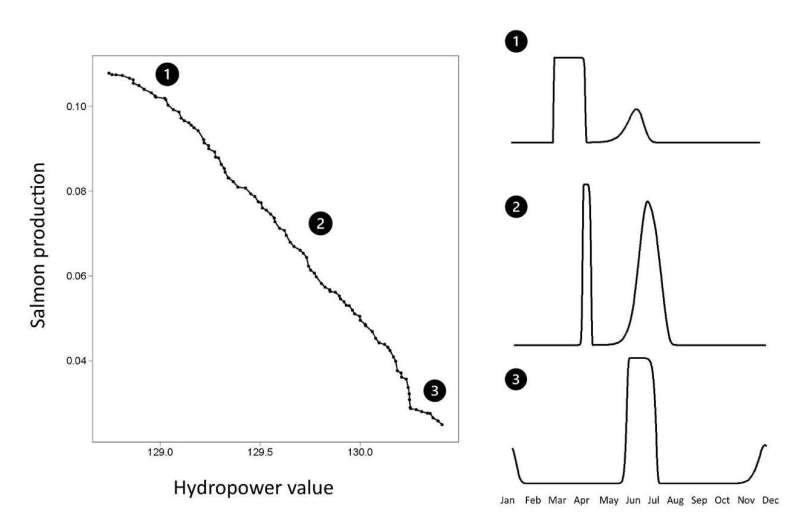Salmon recovery: Conflicts between salmon needs and those of competing water users
by KeAi Communications Co., Ltd.

In the Western U.S., water scarcity is a pressing issue, and strikes a balance between providing flow when it is needed to support migratory fish habitats, like salmon and steelhead.
Simultaneously meeting the needs of irrigators and hydropower producers has proven to be a notable challenge. Even with ample stored water available, it can still be difficult to coordinate flow releases that can satisfy all demands. As climate conditions continue to grow warmer and drier, finding solutions that simultaneously address the needs of fish, energy production, and other water demands will become increasingly challenging.
To that end, two scientists at Oak Ridge National Laboratory explored the optimal scheduling of flow releases from a reservoir in California, U.S., to simultaneously benefit salmon populations and maximize electricity generation. The study’s findings were published in the journal Water Security and Biology.
“Tensions among competing water uses are high in the Central Valley of California,” explained Henriette Jager, co-author of the study. “Reservoirs serve multiple purposes, including support for migratory fish populations. Wild spawner returns of fall-run Chinook Salmon to Central Valley rivers have declined at an average rate of 1,947 adults per year since 1950, accompanied by substantial year-to-year fluctuations.”
The duo developed models to understand how flow releases from a California reservoir could be scheduled to benefit salmon while maximizing the value of electricity generation. Dr. Rocio Uria-Martinez, an energy economist, modeled seasonal patterns in energy value, while Dr. Jager modeled salmon responses to flow.
When combined in an optimization, the models produced a Pareto-optimal frontier of seasonal flow patterns. The candidate flow regimes consisted of two pulse flows with variations in magnitude, timing and duration. These regimes were further constrained by maintaining a total annual flow close to the historical median.
The study’s results indicate whether flow regimes that are good for salmon rearing would also allow hydropower generation at times when electricity demand and prices are high. The analysis revealed times when the economic and salmon objectives aligned, as well as times when they diverged.
Optimal flow regimes satisfying both salmon and hydropower objectives provided pulse flows in early summer. However, only the solutions emphasizing hydropower value included high flows during mid-winter.
According to the study’s other author, Dr. Rocio Uria-Martinez, “The economics of California’s grid is complex, but we were mainly interested in seasonal climate signals. For example, electricity demand should be higher when the air conditioning and heating come on.” The results of the study provide valuable insights into how reservoirs can operate to simultaneously meet the needs of salmon populations and electricity users.
More information:
Henriette I. Jager et al, Finding middle ground: Flow regimes designed for salmon and energy value, Water Biology and Security (2023). DOI: 10.1016/j.watbs.2023.100183
Provided by
KeAi Communications Co., Ltd.
Citation:
Salmon recovery: Conflicts between salmon needs and those of competing water users (2023, July 4)
retrieved 4 July 2023
from https://phys.org/news/2023-07-salmon-recovery-conflicts-users.html
This document is subject to copyright. Apart from any fair dealing for the purpose of private study or research, no
part may be reproduced without the written permission. The content is provided for information purposes only.
For all the latest Science News Click Here
For the latest news and updates, follow us on Google News.

